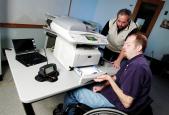Human-factors considerations that help GTRI scientists design user-friendly cockpits for fighter pilots can also help disabled and elderly individuals easily use office equipment and consumer products.
Manufacturers contract with GTRI's Accessibility Evaluation Facility to assess photocopiers, ATMs, cell phones, televisions, printers, scanners, and other equipment to determine if their products meet federal usability and accessibility standards. The 2001 Rehabilitation Act requires that federal agencies consider accessibility before purchasing electronic and information technology equipment. GTRI's work with manufacturers involves field testing with potential users and objective evaluations based on technical standards for accessible design and sound human-factors design principles.
To support their efforts, researchers at GTRI and Georgia Tech's Center for Assistive Technology and Environmental Access created the Accessibility Assistant, an online evaluation tool. The Accessibility Assistant includes a comprehensive database of more than 400 accessibility guidelines that direct rigorous accessibility testing for various types of products. From this database, researchers customize a relevant checklist of guidelines for each product type.
Following a product evaluation, researchers may recommend improvements following the concept of universal design — an approach in which a product is designed to be as accessible to as many different types of users as possible. One example of universal design is a cell phone created for people who are hard of hearing. It would also be useful for people who are talking on their phones in noisy environments.
Accessibility for Arthritis Sufferers
GTRI also conducted evaluations for the Arthritis Foundation. The evaluations helped determine a product's ease of use for arthritis patients, who have upper- and lower-mobility issues, including difficulty grasping and lifting, as well as reduced sensation.
Researchers evaluated products based on an arthritis-specific set of accessibility guidelines, as well as user testing by people with the disease. Products evaluated included a garden sprayer, household cleaning tools, coffee packaging, self-injection and home medical care monitoring kits, gloves, pill bottles, juice containers, golf clubs, and beds.
Accessibility in the Office
Human-factors considerations that helped GTRI scientists design user-friendly cockpits for fighter pilots can also enable disabled and elderly individuals to easily use office equipment and consumer products.
GTRI researchers in the Electronic Systems Laboratory have developed a methodology for determining the accessibility of office machines and other electronic and information technologies. The procedure is intended to identify design changes that would make electronic devices easier to use by people with physical or cognitive disabilities. In addition, meeting federal accessibility standards is a prerequisite for companies that want to secure government business.




